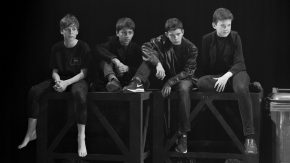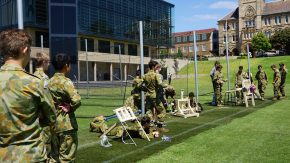A Derelict of the Air
Any death in war is tragic, but sometimes the circumstances are so extraordinary as to make a fascinating story. One such story concerns Lieutenant Lionel Sandy, an Old Newingtonian who died in an air combat over France just on a hundred years ago.
James Lionel Sandy entered Newington College in 1898, but it is not clear how long he stayed. He was working in his father’s business when he enlisted in August 1914. Serving in the Artillery, he was wounded at Gallipoli. After recovering in England, he volunteered for the Royal Flying Corps and was sent to Australia for training. At the end of 1916, he was posted as a pilot to an Australian squadron in France. On 17 December 1917, he and his observer, Sergeant Henry Hughes, took off in their RE8 biplane on an artillery observation mission over the German lines. What happened next was recounted three times in The Newington over the following years: in his obituary published in March 1918, and again in 1933 and 1937, since ‘the story is one that does not weary with repetition.’
Returning to his airfield, Sandy’s plane was attacked by six German Albatross scout planes. Instead of trying to escape, he and Hughes fought back and forced one of the German planes to land in the Australian lines, its pilot wounded: his Albatross is now in the Australian War Memorial. Sandy and Hughes continued the unequal contest until they were joined by two more RE8s, when the Germans drew off. At some point, however, they were hit: the German squadron’s leader flew close to their plane and saw that both Australians were dead, having both been hit, it was later discovered, by a single bullet. Their plane, however, was largely undamaged and it appeared to their comrades that they were alright. Observers on the ground saw the plane fly in increasing circles and eventually disappear over the horizon.
The plane was missing until it was found the following night, largely intact and with Sandy and Hughes strapped in their seats, in a field over forty miles away. After they died, as their Commanding Officer reported, ‘the machine had flown itself until the petrol supply ran out’. It had then glided and landed in a field at least an hour after the combat ended. As described in the 1933 account, ‘the plane was a derelict of the air’.
Sandy and Hughes were buried in the cemetery of a nearby military hospital. They were recommended for the Military Cross and the Distinguished Conduct Medal, but these were not approved. Lionel Sandy’s brother Harold, who came to Newington in 1901, was awarded the Military Cross in August 1918.
One of the brass memorial plaques in the Chapel Walkway, originally erected in the Prescott Hall, commemorates Lionel Sandy, while another plaque was dedicated at his father’s business in 1920 by his workmates. A less formal memorial was formed by photographs of his plane in Newington’s ‘No. 12 classroom’ in the 1930s.
David Roberts
College Archivist






